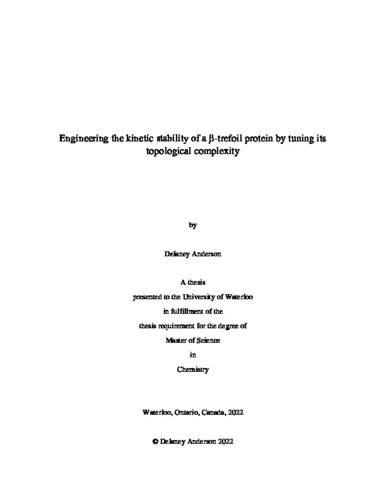| dc.description.abstract | Kinetic stability is crucially important for engineering stable proteins suitable for use in industrial, research, and medical applications. Specifically, kinetic stability is central to determining a protein’s functional lifetime, where high kinetic stability generally correlates with high resistance against chemical and thermal denaturation, as well as proteolytic degradation. Despite its significance, few studies address the rational design of kinetic stability, and specific mechanisms of kinetic stability remain largely unknown. Here, we describe a method for designing protein kinetic stability by engineering long-range intramolecular interactions by taking advantage of conserved residue interactions in structurally homologous proteins. Specifically, we base our design on the extreme difference in kinetic stability observed between the β-trefoil proteins hisactophilin and ThreeFoil, which we partially attribute to a marked difference in the number of long-range interactions across the protein core. We report the design and characterization of a kinetically stabilized hisactophilin variant, core-swapped hisactophilin, mutated to contain ThreeFoil core residues in order to enhance long-range contacts in the hisactophilin core. Further, we show that kinetic stability predictions for core-swapped hisactophilin based on long-range order, absolute contact order, and simulated free energy barriers of unfolding are in good agreement with experimentally determined kinetic unfolding rates. In addition to highlighting the predictive power of simple measures of protein topology for changes in protein kinetic stability, these results emphasize core engineering as an attractive and tractable target for improving kinetic stability, particularly in proteins with symmetric cores. Thus, this work provides fundamental insight towards advancing our predictive understanding of kinetic stability and better enabling successful protein design. | en |

